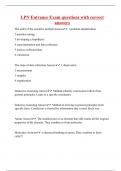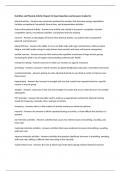Goal 1: Explain why relationship building and engagement are important in HRM
Human resources (HR) → The people within an organization. The management of HR directly affects
company performance. Most valuable organizational resources.
Employee engagement → A combination of job satisfaction, ability, and a willingness to perform for the
organization at a high level and over an extended period of time.
Engaged employees are those who understand what they need to do to add value to the organization
and are satisfied enough with the organization and their roles within it to be willing to do whatever is
necessary to see to it that the organization succeeds.
If an organization manages HR more successfully than competitors, if it can get employees involved in
working toward day-to-day success, and if it can get them to stay with the organization, then it has a
much greater chance of being successful, with successful being more productive and profitable.
Goal 2: Identify difference between traditional view of HRM and present view
In the past, HR department was considered to be a cost center → A division or department that brings
in no revenue or profit for the organization.
Revenue centers → Divisions or departments that generate monetary returns for the organization.
HRM departments do not generate revenue directly, but they can generate significant revenue and profit
in an indirect way. Revenue centers are the present view of HRM.
Productivity center → A revenue center that enhances the profitability of the organization through
enhancing the productivity of the people within the organization. The function of managers now is to
improve organizational revenues and profits. HR creates revenue by enhancing the productivity of the
people within the organization.
Productivity → The amount of output an organization gets per unit of input, with human input usually
expressed in terms of units of time. Productivity is the end result of two components that managers work
to create and continually improve within the organization:
1. Effectiveness → Function of getting the job done whenever and however it must be done
2. Efficiency → Function of how many organizational resources were used in getting it done
HRM deals primarily with improving the efficiency of the people within an organization. One way to
improve efficiency is the use of technology, especially people analytics.
Goal 3: Identify major challenges that HR managers face in a modern organization
Many of the top concerns include the issue of people and their performance. Ability to analyze large
data sets allows HRM to work toward overcoming another of their challenges: creating strategic agility.
,Demographic changes in the labor force will affect companies over the next 20 years. Businesses will
also become far more diverse, with a focus on creating an inclusive environment with equal opportunity
and acceptance for all employees. Factors that will affect the ability of HR to provide the organization
with the right numbers and types of employees are:
1. Aging of the workforce
2. Skills shortages
3. Integration of AI
Managers also need to be more culturally aware and able to deal with individuals with significantly
different work ethics, cultural norms, and even languages.
Knowledge workers → Workers who use their head more than their hands and gather and interpret
information to improve a product or process for their organizations. There is a continuous shortage of
knowledge workers. Result is that HR managers are competing with other HR managers for the pool of
knowledge workers.
One of the most critical issues HR managers face is the fact that technology is outpacing our ability to
use it at an ever-increasing rate. Continuously figure out ways to use the technology more successfully
through hiring and training better and more capable knowledge workers. Before competitors do.
Ability within people creates a continuing advantage over competitors who either don’t have people with
numerous and varied knowledge and skills or don’t have people who want to assist the organization
because they are not engaged and not satisfied.
Goal 4: Describe the four critical dependent variables that managers must control in order to compete
Dependent variables are the items that can only be affected through indirect means. We have to control
some other variable (independent) because we can directly control it to affect these items. The most
important and difficult things to deal with are:
1. Productivity → Amount of output an organization gets per unit of input.
2. Employee engagement → Combination of job satisfaction, ability, and a willingness to perform
for the organization at a high level and over an extended period of time.
3. Turnover → Permanent loss of workers from the organization.
4. Absenteeism → Failure of an employee to report to the workplace as scheduled.
Managers have no direct control over these things. Only through indirect actions. It’s always necessary
to do things that will improve productivity and employee engagement and that will reduce turnover and
absenteeism. These items are critical.
The function of HR has been redesigned to make organizations more competitive and to create sustain-
able competitive advantages → A capability that creates value for customers that rivals can’t copy
quickly or easily and that allows the organization to differentiate its products or services from those of
competitors. Basis of strategic HRM.
,Some of the most common areas where social media is put to use:
1. Recruiting and selection → Little or no cost to the company, platforms like LinkedIn.
2. The onboarding process → To inform and enculturate new members of an organization.
3. Training and development → Like formal mentoring and development communities.
4. Performance management → Platforms can be used for continuous feedback.
Goal 5: Describe the four major HRM skill sets
Set of necessary HR skills is similar to the skills needed by other managers, but, it emphasizes people
skills more than some other management positions do. Four major HRM skills are:
1. Technical skills → The ability to use methods and techniques to perform a task, like computer
skills, interviewing skills, training knowledge and skills, etc.
2. Interpersonal skills → The ability to understand, communicate, and work well with individuals
and groups through developing effective relationships. HR managers need strong interpersonal
skills to lead employees. They have to be empathetic. Empathy → Ability to put yourself in
another person’s place. To understand not only what the person is saying but why the individual
is communicating that information to you while remaining emotionally detached.
3. Conceptual and design skills → The ability to evaluate a situation, identify alternatives, select
a reasonable alternative, and make a decision to implement a solution. Conceptual part is an
ability to understand what is going on in business processes. Design part allows us to figure out
innovative solutions to problems that we have identified through the use of our conceptual skills.
4. Business skills → The analytical and quantitative skills that are necessary to understand and
contribute to the profitability of the organization. HR professionals must have knowledge of the
organization and its strategies if they are to contribute strategically.
Technical and business skills are concerned with things, interpersonal skills are primarily concerned with
people, and conceptual and design skills are primarily concerned with ideas and concepts.
Goal 6: Discuss the line manager’s six HRM responsibilities
Line managers → The individuals who create, manage, and maintain the people and organizational
processes that create whatever it is that the business sells. They control the actual operations.
Staff managers → Individuals who advise line managers in some field of expertise.
Major HR responsibilities of line management are:
1. Legal considerations → Employment, workplace safety, health, labor laws, etc.
2. Labor cost controls → What can and can’t line managers do to minimize labor costs?
3. Leadership and motivation → Improve workers performance and productivity through motivation
4. Training and development → Line managers are generally first to see a problem in a process,
which is frequently an indication that some type of training is needed. Recognize need training.
5. Appraisal and promotion → Responsible for debriefing individuals on their annual evaluation.
6. Safety and security of employees → Maintaining safety and security of workforce.
, Goal 7: Describe the eight major HRM discipline areas
Most HR jobs are either generalist jobs, in which the HR employee works in many different areas, or
specialist jobs, in which the employee focuses on a specific discipline of HR. Major discipline areas are:
1. Legal environment, EEO, and diversity management → Involved with the management of the
organization’s employee-related actions to ensure compliance with equal opportunity laws and
regulations, as well as organizational affirmative actions plans.
2. Staffing → Includes all of the things we need to do to get people interested in working for the
company. Going through recruiting process, selecting the best candidates, and getting them
settled into their new jobs.
3. Training and development → Employees who participate in more training and development are
less likely to leave the company and less likely to engage in neglectful behavior.
4. Employee and labor relations → Involves things like coaching, conflict resolution, counseling,
employee evaluation, disciplining, leadership, and team-building efforts.
5. Compensation and benefits → Deals with how we reward people who work for the organization.
6. Safety and security → Ensure that work environment is safe to that on-the-job injuries, illnesses,
and other negative events are minimized.
7. Ethics and sustainability → Responsibility for seeing to it that the organization acts in an ethical
and socially responsible manner. Sustainability is meeting the needs of today without sacrificing
future generations’ ability to meet their needs.
8. People analytics → Discipline where computers and large databases are utilized to analyze
patterns in the work environment. Take actions to change or address expected issues.
Goal 8: List some of the major resources for HRM careers
Society for Human Resource Management (SHRM) → The largest and most recognized of the HRM
advocacy organizations in the United States. What they do:
1. Advocacy for national HR laws and policies for organizations
2. Training and certification of HR professionals in a number of areas
3. Provides its members with a place to network and learn from peers
Other organizations:
1. Associations for Talent development (ATD) → Supporting those who develop the knowledge,
skills, and abilities of employees in organizations around the world.
2. Human Resource Certification Institute (HRCI) → Provides some of the most respected certi-
fications for HR personnel anywhere in the world.
3. WorldatWork → Mainly deals with compensation, benefits, and performance management.




